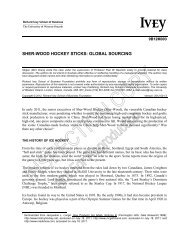foundation of canada asia pacific - Content Tagged with
foundation of canada asia pacific - Content Tagged with
foundation of canada asia pacific - Content Tagged with
Create successful ePaper yourself
Turn your PDF publications into a flip-book with our unique Google optimized e-Paper software.
NORTH AMERICAN INTEGRATION<br />
4<br />
too much<br />
<strong>of</strong> a good thing?<br />
45<br />
The biggest obstacle to greater Canadian economic involvement in Asia is the lure <strong>of</strong> the<br />
US market. Huge, rich and relatively open to Canadians, the US is the obvious foreign<br />
market <strong>of</strong> choice for businesses. The more distant and difficult markets <strong>of</strong> Asia run a<br />
poor second, no matter how promising their long-term growth prospects. Canada’s<br />
involvement <strong>with</strong> our giant neighbour is so extensive and apparently inevitable that<br />
thoughtful commentators and economists suggest we should further strengthen our ties<br />
by entering into a customs union <strong>with</strong> the US or even adopting a common currency. 1<br />
However, it is important to ask how much <strong>of</strong> the integration in the North American economy<br />
goes beyond our fundamental economic compatibility and is driven by government policy<br />
decisions or businesses’ risk aversion. If we have tied our wagon a little too tightly to the<br />
US because <strong>of</strong> political fiat rather than economic rationale, we have to be concerned<br />
that the level <strong>of</strong> integration may ultimately have a detrimental impact on Canada. This<br />
leads to questions about the effect that even greater levels <strong>of</strong> integration would have on<br />
our relationship <strong>with</strong> other regions, specifically Asia. Our close economic relationship<br />
<strong>with</strong> the US is Canada’s overriding exercise in globalization. But the globe extends well<br />
beyond the 49 th parallel.<br />
By most measures, Canada’s economy appears closely integrated <strong>with</strong> the US — the border<br />
between us is only a limited impediment to trade and commerce, as the figures show.<br />
Some 68% <strong>of</strong> foreign direct investment in Canada is from the US, while nearly 53% <strong>of</strong><br />
Canadian direct investment abroad is in our southern neighbour. About 53% <strong>of</strong> foreign<br />
portfolio investment in Canada — in both stocks and bonds — is held in the US, including<br />
94% <strong>of</strong> all Canadian stocks owned by foreigners. Similarly, 58% <strong>of</strong> overseas portfolio<br />
investment by Canadians is in the US. In recent years, cross-border investment has leveled<br />
<strong>of</strong>f. However, that plateau <strong>of</strong> cross-ownership is clearly at a high level already.<br />
Our trade ties are even greater than our investment links: fully 85% <strong>of</strong> Canadian exports<br />
in 1998 went to the US, which in turn provided 68% <strong>of</strong> our imports. Much <strong>of</strong> this exchange<br />
is taking place at an intercompany level. It is estimated that nearly 50% <strong>of</strong> Canada-US<br />
trade is between parts <strong>of</strong> the same business group, 2 <strong>with</strong> components or finished goods<br />
from a plant on one side <strong>of</strong> the border supplied to an associate on the other side. The<br />
interchange <strong>of</strong> similar products shows up even in our gross trade pr<strong>of</strong>ile: eight <strong>of</strong> the<br />
top ten Canadian export categories to the US rank in the top ten US exports to



